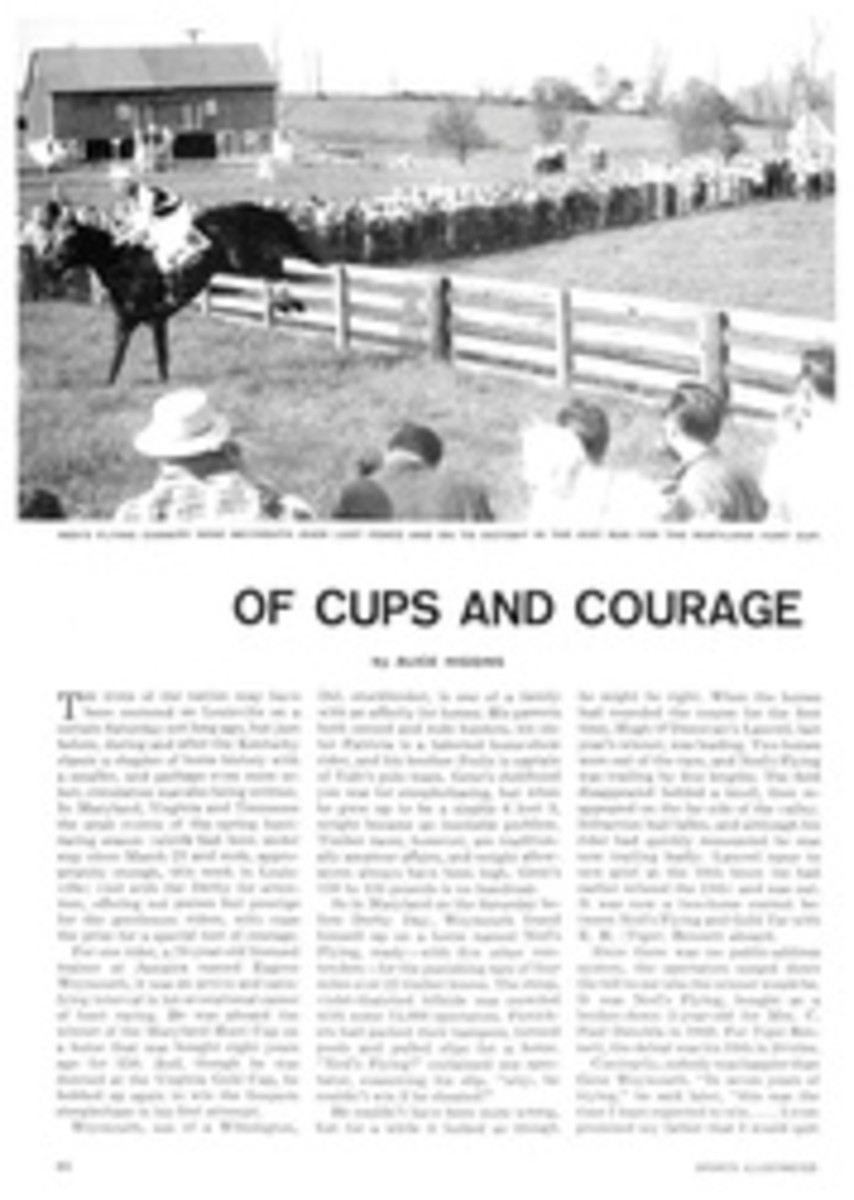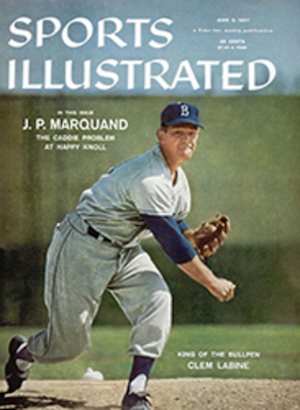
THEY CALL HIM MR. TROUBLE
In the helter-skelter existence of the touring professional golfer, where toughness of mind and spirit are the prime requisites for survival and a sound game is an almost incidental necessity, Douglas Michael Ford reigns as king. This year he has already won $30,000, almost twice that of the second-place money winner, and with the Masters championship to go with his large bundle of prize money Mr. Ford, of Yonkers, N.Y., is doing right well for himself.
Going on the professional golfing tour is one of the toughest ways ever devised to make a living. In the first place, there is only about half enough money distributed in prizes to pay for the $125 to $300 a week expenses incurred by each of the 50 to 400 pros who enter the tournaments. A second difficulty for the touring pro is that, technically speaking, he is traveling among enemies and not with teammates. Antagonisms develop between players and self-protective cliques are formed almost as a matter of course. One veteran pro is still bitter about his early days on the tour when even in crowded country-club dining rooms he and his young wife used to face the specter of two empty chairs at their table because of the careless, or studied, refusal of other pros to sit down and eat with a "nobody." It finally reduced his wife to tears.
Ford, however, has survived the bruises of professional golf in good fashion and is now solidly ensconced as one of its institutions. He is always generous with advice or encouragement to the newcomers on the circuit. He can point with satisfaction to his own house in Yonkers, N.Y., his pretty wife Marilyn and their two sons and one daughter. He is on the advisory staff of the Dunlop Rubber Corporation (at $3,000 per year plus a $5,000 bonus each time he wins either the Masters, PGA, U.S. Open or Canadian Open), the Golfcraft equipment company ($6,000 per year) and is the playing pro at the Putnam Country Club in Mahopac, N.Y. (at $6,500 per year).
TIME TO RETIRE
Though his success this year makes such a possibility seem inconceivable, as recently as last fall this burly, dark-haired son of one golf professional and nephew of three others, was so discouraged with his game that he was ready to abandon the tour and go into at least a temporary retirement. Reared on the municipal courses in and around New York, Ford had turned pro in 1949 at the age of 26 after many years as one of the East's top amateurs. Now, after seven successful seasons and only one year after winning the 1955 PGA, he seemed to have lost his way.
But every career has a turning point, and this point for Ford came last September during the Metropolitan Open. "I was so discouraged about my game," he confessed recently, pushing fingers through thinning black hair, "that I had decided to take about six months off. I hadn't been getting any distance off the tee and I hadn't been winning any money. My game had become so conservative that I had just about stopped scoring."
For several years he had been fading the ball (hitting with a slight left to right drift) and until 1956 had been winning that way. "But during the Metropolitan Open," Ford continued, "the wind was blowing like hell and I had to switch tactics and start hooking the ball into the wind."
Playing "hooky" in this highly acceptable manner Ford battled the wind for three rounds, and on the final afternoon when the wind abated he turned in a record 66 for the par 73 Inwood Country Club course and for the first time in a year won a tournament. The hook had come to stay.
Thus encouraged, Ford plunged back into major league competition and started winning substantial purses once again. This January he won the Los Angeles and Panama Opens, and climaxed his return to form with the Masters victory at Augusta in April.
Ford has an approach to tournament golf that is shared by most of the other touring professionals, but it is quite a change from the days 40 years ago when Walter Hagen led professional golf out of the back alleys and into the realm of respectability with his swashbuckling, go-for-broke flair in which anything less than first place was dismal ignominy.
"With rare exceptions I never go into a tournament to win," Ford states quite firmly. "What I aim for is just a nice, comfortable chunk of the prize money."
Naturally, it takes a consistently low-scoring game of golf to follow this formula successfully, and one method that Ford uses to maintain the sharpness of his game is to be sure, even in practice rounds, that money is riding on every shot. In warming up for a tournament it is common for him to play $5 and $10 Nassau in practice games, frequently with Dow Finsterwald and former Amateur Champion Arnie Palmer, two young touring professionals who are also consistently in the money.
"It's unusual for me to ever play a 'friendly' game of golf," Ford admits quite seriously. "You learn much more by having a little something on the game and you're able to keep yourself much sharper, much tighter. If I just kid around I start getting sloppy and careless."
Watching Ford out on the course is not the esthetic experience one can obtain by following Ben Hogan or Sammy Snead. His swing is extremely flat, possibly because his left shoulder does not come around nearly enough, and his drives are hit very low and not very accurately (by his own admission he is "king of the ground hogs"). But one must marvel at the way he scrambles through round after round and yet still turns in winning scores. He will regularly go from tee to rough to sand trap, but he has mastered his short game so thoroughly that trouble of this sort seldom costs him strokes.
Contrary to popular belief, he is as relaxed playing his rounds as any golfer on the circuit. He is all business over the ball, but between shots there is seldom the display of temper or even the petty show of annoyance that characterizes so many golfers who have mis-hit a shot. Around the tee it is not exceptional for him to chat with members of the gallery, wink at an acquaintance or pat the head of a small boy who looks up slack-jawed with awe (and perhaps a certain element of fright) at this swarthy, tanned giant who could as well be Captain Kidd brandishing a cutlass as Doug Ford uncovering his driver.
STILL TWO TO GO
Having won the Masters, Ford still has two formidable tournaments ahead of him this year—the U.S. Open on June 13-15 at Inverness and the PGA at Dayton in July. Naturally, for the Open he intends to cast aside all remnants of his "go for the chunk" philosophy because there is no title like an Open title.
"Physically the PGA is a harder tournament," he says, "but nothing can match the pressure to win that exists at the Open. Every golfer there can feel the terrific tempo. You get all charged up like a kid about to enter his first tournament. And if I had to pick a winner I'd take Snead. He's won a lot of four-ball tournaments at Inverness and plays that course like he owns it.
"I'll also do everything I can to win the PGA," Ford adds, "even though I don't care for match play [actually, his match-play ability is highly respected]. When I won at Northville in '55 I was just trying to shoot a score and I didn't care who I was playing, but I seldom have the concentration to operate that way. I think if a guy could concentrate like that all the time he wouldn't get beaten in match play very often."
It is Ed Furgol, who overcame the handicap of a crooked left elbow to win the National Open in 1954, who summarizes perhaps best of all the reasons for Ford's current success, and why he will probably be a winner for many years to come.
"There are about 25 golfers on the tour who can play just as well as Doug Ford," he says, "but he has the interest and enthusiasm and spirit that they lack. He just simply loves everything about the game of golf."
PHOTO
FORD'S FAVORITE SHOT. FROM TRAP TO PIN
TWO PHOTOS
AT MASTERS (BELOW), A GEYSER OF WATER

